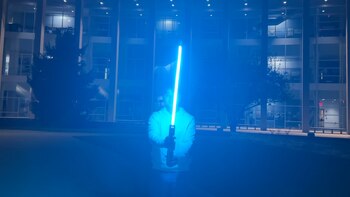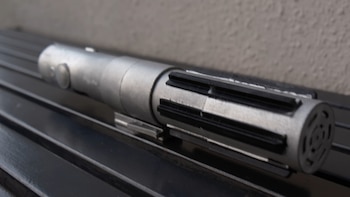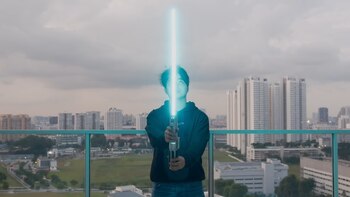Since the beginning of the Star Wars saga in 1977, lightsabers have become a symbol of popular culture and one of the favorite dreams of science fiction fans. Today, that adventure is one step closer to reality thanks to HeroTech, a YouTuber and creative engineer who has designed a realistic flashlight that automatically extends and retracts, mimicking the visual effects we see in movies.
To achieve this design, the content creator used several technological devices like LED lights, to give it the special touch that we see the Jedi use in their fights in the saga.
The key to the design of a HeroTech flashlight does not lie in a high-tech laboratory, but in the world of magic. In a video shared on his YouTube channel, HeroTech explains that its prototype is inspired by the apparition magic staff, a magic trick that allows an object to be hidden quickly.

These staffs, which are made of a sheet of steel that is quickly wound, expand with a quick movement, suddenly when a pin is released. This expansion kit was his preferred solution to replicate the lightsaber’s power-up feature, a challenge that many previous attempts by other Star Wars enthusiasts had failed to solve.
The magic staff works in a simple way: once the pin that holds the steel coil is released, the staff expands quickly, expanding to its full length in a second.
However, there is a disadvantage for those who want to imitate the effect of lightsabers: the baton does not retract on its own.. The YouTuber needed a solution so that the saber could be turned on and off, a fundamental aspect to reproduce the visual experience of the films.
To achieve power on and off, HeroTech integrated an LED strip into the design, which serves two purposes: it not only illuminates the saber like a Jedi signature light blade, but it also acts as a flexible “cable” that allows the staff to extend and retract. This design uses an internal motor and reel to wind and release the LED strip, simulating the effect of a light fixture that appears and disappears as the user being activated.

The LED strip is placed inside the steel sheet, allowing it to emit light throughout the saber blade. The combination of these mechanical and electronic elements is the heart of the modern design.
Although it may seem like a simple idea, it required precise calculations and great attention to detail to achieve this design, as the LED strip and baton mechanism had to be synchronized to move to produce a smooth, controlled process that would not cause accidents or equipment failure.
Despite the advances that have been made, this flashlight is not free from limitations. One of the main problems that still needs to be solved is that the LED strip only illuminates two sides of the blade, which means that the saber does not offer a complete 360-degree illumination, as in the special effects of the film saga. This means that from some angles, the saber does not appear to be fully lit, which reduces realism for those looking for an accurate replica.
To solve this problem, the content creator has proposed a development plan: implement a system that allows the LED strip to move inside the saber cover at high speed. In this way, the light would be projected in all directions, imitating a page with uniform light.

Interestingly, this method is similar to the method used to create visual lighting effects in the early Star Wars films, in which actors used rotating sticks that reflected light in all directions. side However, it will be a challenge to integrate this equipment in a small space, as the falcon already contains several components.
In addition to the lighting and power-up kit, HeroTech has included additional details to enhance the user experience: the light fixture features a built-in speaker into the show that plays the signature sounds of Jedi sabers, such as the power-up hum and the sounds they make when they move or collide with other objects. These sound effects have been taken directly from the Star Wars movies and give the saber an extra touch of mystery.
2024-10-28 03:11:00
#Star #Wars #lightsaber #reality #technology

